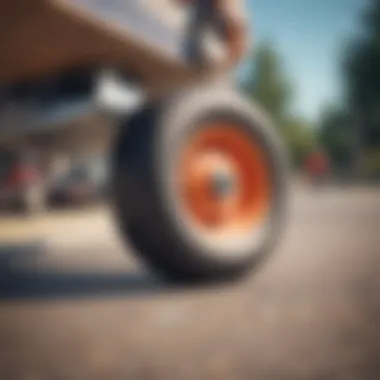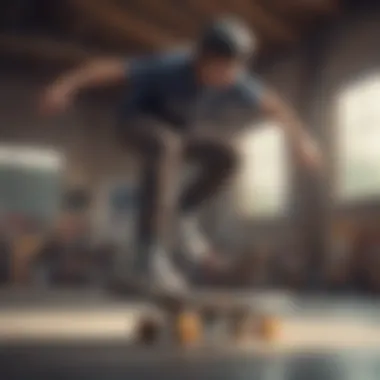Choosing the Right Skateboard for Kids Aged Nine


Intro
Choosing the right skateboard for a nine-year-old is much more than just picking a board off the shelf. It requires a keen eye on safety, the skill level of the child, and how well the skateboard's design fits their needs. Young skaters, full of energy and enthusiasm, need equipment that not only meets safety standards but also encourages them to explore their skating passion.
The excitement of skating should be matched by the assurance that the board is suitable for the user. After all, a board that feels right can help kids develop confidence, skills, and a sense of belonging in the skating community. Parents often find themselves caught in a whirl of choices and technical jargon, which can feel overwhelming. That's where this guide comes in—to simplify the selection process and unlock the world of skating for young riders.
"Finding the right skateboard is like finding the right pair of shoes—comfort and fit make all the difference."
This article delves into crucial elements such as the types of skateboards ideal for children, must-have features to look for, and advice drawn from user experiences and expert insights. We'll also touch upon the aspects of safety that can't be overlooked. The ultimate goal is to furnish parents and guardians with the knowledge to make an informed choice, ensuring that their young skater has the right tool to foster a lifelong love for the sport.
Understanding Skateboard Options for Young Skaters
Selecting the right skateboard for a young rider is pivotal. It's not just about choosing a random board off the shelf; the type of skateboard determines the ease with which a child can learn and enjoy the sport. Each model caters to different aspects of skateboarding, whether it’s cruising, tricks, or a blend of both. Understanding skateboard options helps parents make informed decisions that align with their child's interests and physical characteristics.
Types of Skateboards Available
Longboards
Longboards are quite popular among young skaters, especially for those who lean toward cruising rather than tricks. A standout aspect of longboards is their extended length, which often provides more stability. For young riders still developing balance, a longer deck can make the ride smoother, thus boosting confidence. Its smooth gliding on various surfaces can make the experience enjoyable. However, the extra length can also pose a challenge for tighter spaces or trick-oriented practices; navigating obstacles might be less agile compared to shorter boards.
Standard Skateboards
Standard skateboards are often recognized as the quintessential board for those interested in tricks and street skating. Their shorter decks, typically around 28 to 32 inches, make them ideal for maneuverability. Child can easily learn ollies and flips, which contribute directly to their skill development. The compact nature allows for easier transportation, making them a handy choice for skaters on the go. However, standard skateboards might be less forgiving for beginners still mastering their balance, as the smaller surface area sometimes requires more precision.
Mini Skateboards
Mini skateboards are tailored for younger or smaller skaters, making them an excellent entry point. The boards are shorter and lighter, making them easy to control. A major advantage here is the lightweight design, which reduces the effort needed to kick and push. These characteristics foster confidence and help develop fundamental skills, but the trade-off is that they may not be as stable as their larger counterparts. Thus, they’re best suited for cruising at lower speeds rather than high-impact tricks.
Importance of Size and Weight
Proportionality of Skateboard Dimensions
The dimensions of the skateboard directly influence its performance and suitability for young users. A properly proportioned skateboard helps ensure that the child can both manage and maneuver effectively. Boards that are too large can hinder control, while those that are too small might make it hard to gain sufficient speed or stability. For nine-year-olds, finding a size that matches their height and balance skills is key for a joyful skating experience.
Influence of Weight on Control
Weight plays a significant role in how a skateboard behaves, particularly regarding control. A heavier skateboard can offer more stability on rough surfaces, but it may also be challenging for a child to push or turn. Conversely, a lighter board enhances maneuverability and is easier for novice skaters to handle. However, if it’s too light, it could feel flimsy and less stable, particularly in more dynamic skating scenarios. Balancing these factors is crucial to ensure the selected skateboard complements the child's skill level and confidence.
Key Features to Look for
Selecting the right skateboard for a nine-year-old isn't a snap decision; it's more like piecing together a puzzle. Key features play a pivotal role not just in performance, but also in safety and durability. This section delves into those features that help shape the experience, laying out what to consider while making your choice.
Deck Material and Durability
Common Deck Materials
When it comes to skateboard decks, the materials used can make all the difference. The most popular options include maple, bamboo, and plastic. Maple is a classic choice, known for its robustness and flexibility, which is essential for tricks and safe riding. It's like the sturdy backbone of the skateboard family; you won't go wrong with it. Bamboo, though a bit lighter and eco-friendly, is still strong enough for young skaters who are just starting. Plastic decks are lightweight, ideal for kids under nine, but they may not withstand the wear and tear as well as wood.
Consider the unique characteristics of these materials. Maple decks can last a long time if cared for properly. Bamboo has some impressive shock absorption but might not last as long under heavy usage. Plastic is generally not the go-to for serious skaters, as it lacks that much-needed structural integrity.
Assessing Deck Durability
Durability falls squarely within the parameters of long-term use. Young skaters are prone to dropping their boards, and a durable deck means fewer worries about damage. Evaluating durability involves checking the construction quality and finish of the skateboard.


A solid deck often features multi-layer construction, specifically around seven layers for maple boards, whereas single-layer boards are more susceptible to cracks. Look for boards that have been treated or finished through various processes, like epoxy coatings, which enhance their overall lifespan. The unique feature of a high-durability deck becomes apparent when skaters can use it without frequently replacing due to breaks.
Trucks and Their Specifications
Functionality of Trucks
Trucks are essentially the heart of the skateboard. They dictate how well it maneuvers and how stable it feels, especially for younger riders trying to make their way around a skatepark. The trucks connect the wheels to the deck, allowing for turns and tricks.
A well-functioning truck helps in promoting an even weight distribution, making it easier for novices to find their balance. A common feature is the adjustable height, which permits fine-tuning the skater's experience. Newer riders generally do not need ultra-premium trucks; a good set at moderate price will do the trick until they gain experience.
Optimal Truck Width for Young Users
Truck width plays a significant role in stability during skating. For nine-year-olds, the ideal width sits between 5.0 to 7.0 inches. Wider trucks offer more stability, allowing young riders to feel secure. However, overly wide trucks might hinder their ability to perform tricks.
Finding that "just right" width is crucial, as it impacts both performance and safety. Boards fitted with appropriately sized trucks enable better alignment with the deck, enhancing control. A balanced truck width can be a game-changer for those still finding their footing on the board.
Wheel Size and Hardness
Understanding Wheel Dimensions
Wheel size significantly influences how a skateboard rides. For younger skaters, wheels range typically from 50mm to 55mm in diameter. Bigger wheels provide a smoother ride over uneven surfaces but may complicate tricks. Smaller wheels, on the other hand, offer superior control but can be jarring if the terrain isn’t smooth.
For nine-year-olds, the key is to strike a balance. Choosing the right wheel size can help reduce the risk of falls, as adequately sized wheels enhance grip and stability, allowing a confident ride.
Impact of Wheel Hardness on Performance
Wheel hardness is measured on a durometer scale, usually ranging from 78A to 101A. Softer wheels (78A-87A) grip the external surface better, making them excellent for outdoor use but can wear more quickly. Harder wheels (88A-101A), while fast and ideal for skateparks, offer less grip, which might be challenging for someone new.
The optimal hardness for nine-year-olds typically falls around 83A to 88A, providing that sweet spot of softness for a comfortable ride while remaining hard enough to glide on slick surfaces. This combination can aid beginners in feeling stable while learning the ropes, lessening the chance of slips or bumpy rides that could discourage them from skating.
Safety Considerations
Safety is paramount when it comes to skateboarding, especially for children around nine years of age. This is a critical phase when they begin exploring new skills and pushing their limits. Understanding safety considerations is not just about ensuring they don’t get hurt; it also builds confidence and encourages a positive attitude towards learning the sport. As the saying goes, ‘better safe than sorry,’ and certain precautions can make a world of difference in a young skater’s experience.
Importance of Safety Gear
Helmets and Pads
Helmets and pads are like the security blanket for budding skaters. They protect the most vulnerable parts of their bodies. A sturdy helmet, specifically designed for skateboarding, absorbs shock during those inevitable tumbles. If you’ve watched kids learn to ride, you know they’re bound to fall, so having a helmet can prevent serious injuries. A great feature of many models today is the adjustable fit, making them suitable for growing heads. Parents would appreciate that they won’t have to keep buying new ones every few months!
Additionally, knee and elbow pads offer protection against scrapes and bruises, which are common. Kids may feel more reluctant to fall with the right gear, allowing them to focus on improving their skills instead. Investing in quality safety gear is not just about compliance; it’s about ensuring their enjoyment and fostering a long-lasting love for skateboarding.
Choosing the Right Safety Equipment
When it comes to choosing the right safety equipment, understanding the various types available is key. There are countless options out there, but some really stand out. The best choices are typically comfortable, durable, and specifically designed for young skaters.
Look for pads that are lightweight yet provide adequate cushion, as heavy pads can be a hindrance. Unique features like moisture-wicking material can help in keeping kids dry during longer sessions. One potential downside could be the aesthetic appeal; some kids might not want to wear gear that doesn’t match their skateboard. So, picking gear that comes in fun colors can go a long way in encouraging them to wear it!
Understanding Skateboarding Etiquette
Teaching Respect for Others
Teaching respect for others on a skateboard is like instilling values in everyday life. Kids should learn that skateboarding shares the space with pedestrians, fellow skaters, and cyclists. It’s vital to establish a common ground where everyone feels safe and included. Emphasizing the principle of sharing space can reduce the chances of accidents and foster a community spirit among skaters. Encourage kids to ask, ‘Is this other person in my way?’ rather than barreling through.


A unique characteristic about this aspect of etiquette is its power to create a nurturing environment. When children respect one another, they become more considerate and self-aware, leading to a more enjoyable experience for all involved, though it can take time for young skaters to learn these principles thoroughly.
Promoting Safe Skating Environments
Promoting safe skating environments goes hand in hand with teaching respect. Creating an atmosphere where kids feel secure to express their skills is crucial. This includes picking the right places to skate. For instance, skate parks are specifically designed for this purpose, while busy streets could prove hazardous. The added benefit of skate parks is that they typically come with various features like ramps and rails that serve all skill levels.
One unique feature of a safe skating environment is the presence of other skaters. When kids see experienced skaters demonstrating good behavior and respect for the space, they’re likely to mimic that. However, it’s important to recognize that not all areas are conducive to safe skating; hence, educating kids on where to skate is essential.
Promoting these environments requires ongoing discussion and awareness, but they ultimately enhance the overall skateboarding experience and contribute to a broader culture of safety.
Reviews of Top Skateboards for Nine-Year-Olds
When considering a skateboard for a nine-year-old, reviews serve as a crucial part of the puzzle. They reflect the real experiences of users and the performance of the boards. By examining various feedback and critiques, parents can make choices that align not only with the child's interests but also with safety and usability.
Performance Evaluation
User Feedback and Experiences
User feedback stands out as an invaluable source of information while selecting a skateboard. Kids and their parents often share insights about how well a skateboard performs after initial rides. This type of feedback highlights the practical aspects of a board that specs alone cannot convey.
A key characteristic of user feedback is its relatability. Parents trust reviews where other parents share their excitement or frustration. For instance, when many users celebrate a board’s stability while performing tricks, that creates a sense of reliability for potential buyers. Conversely, reports of stability issues can act as red flags. Unique features like the ease of handling or how quickly a skateboard can turn make particular boards more appealing.
The advantages of real-world experiences can’t be overstated. They provide a clearer picture of whether a product matches the energetic lifestyle of a nine-year-old.
Expert Analysis of Performance
Expert analysis brings a different flavor to understanding skateboard performance. Experts often dissect boards based on technical specifics, offering insights into geometry, material quality, and even brand reputation. This information allows parents to comprehend the underlying mechanics that support user experiences.
The key characteristic here is the rigorous approach experts take when evaluating products. By setting standards based on what young skaters need—like responsiveness and durability—these analyses empower parents to choose wisely. A standout feature includes lab tests that rate a skateboard’s durability against various impacts. However, an expert analysis can sometimes get bogged down in jargon. Readers may find it hard to connect those specs to real-life skateboarding experiences.
Still, the clarity of professional insights often highlights essentials that might go unnoticed in user feedback.
Price Comparison and Value
When the final call comes down to price, ensuring cost-effectiveness is essential. In the realm of skateboards, understanding what you're getting for your money can guide families toward the best option.
Assessing Cost-Effectiveness
Cost-effectiveness is about evaluating whether the benefits of a skateboard justify the price tag. A common query among concerned parents is whether paying more guarantees superior quality. Reviews often tackle this head-on. They weigh the price against features like durability, performance, and brand reliability. Parents need confidence that an investment results in a product that lasts and performs.
Another unique aspect to consider is warranty information, which adds another layer to the cost-effectiveness dialogue. A skateboard that costs a bit more but comes with a solid warranty can provide peace of mind and may save money in the long run if issues arise.
Comparing Features Across Price Ranges
Comparing features across price ranges allows parents to make informed selections based on their budget. Skateboards can vary greatly in cost, and understanding the commonalities among price brackets helps families recognize value.
For example, entry-level skateboards might focus more on basic performance and durability, making them suitable for beginners. In contrast, mid-range boards often incorporate advanced technology or more durable materials, appealing to kids who are progressing in their skills. The unique feature here is that users can often find detailed comparisons through online forums or review sites. These platforms have discussions that can reveal hidden gems in lower price points that don't sacrifice quality.
Ultimately, being savvy about pricing while keeping an eye on crucial features enriches the decision-making process.
Understand that the journey to the perfect skateboard is not only about price and performance; it’s about fostering a love for skating that grows with your child.
Recommendations for Different Skill Levels


When selecting a skateboard for a nine-year-old, it’s crucial to understand how skill level impacts the choice of equipment. Different ages and experiences translate into varying needs and preferences in skateboards. A young skater's comfort and confidence on the board can significantly affect their learning curve, safety, and overall enjoyment of the sport. Tailoring skateboard recommendations to align with their skill levels can set them on a path to not just ride, but thrive on their boards.
For Beginners
Entry-Level Skateboards
Beginning skaters typically need boards that are more forgiving, offering a stable ride as they learn the basics. Entry-level skateboards are designed with these novice skaters in mind, providing more width and stability than advanced models.
A key characteristic of entry-level skateboards is their forgiving design. These boards celebrate simplicity, often featuring wider decks that enhance balance for young users who are still finding their footing in the sport. A board like the Bamboo Skateboards Classic offers a solid surface and a flexible deck that absorbs shocks, making it a popular choice and great for kids just lacing up their first sneakers to skate.
However, one downside could be the weight. Entry-level boards might be slightly heavier, which can be more challenging for smaller hands to handle. Yet, it’s often a trade-off worth considering as the advantages of stability and grip come into play.
Brands to Consider
When talking about brands, there are certainly some that stand out in the entry-level arena. Companies like Element Skateboards and Penny Skateboards not only cater to younger skaters but also prioritize durability and fun designs.
The standout feature of a brand like Element is their commitment to quality coupled with eye-catching aesthetics. Their boards often come in vibrant colors and patterns that resonate with kids, making the sport more appealing.
One potential drawback is the price point of some quality brands. While they generally provide great value, high-quality entry-level skateboards may be a bit of an investment initially, which can sometimes deter those just starting out.
For Intermediate Skaters
Upgrading Options
As a child’s skills progress, their skateboard should too. Upgrading options are an essential aspect of promoting growth beyond the basics. Skaters transitioning from beginner boards typically seek a mix of performance and advanced design tailored to their evolving techniques.
Typically, intermediate boards, like the Santa Cruz Skateboards Complete, introduce features like enhanced wheel types and a more responsive deck. These aspects foster a more dynamic riding experience, allowing for tricks and variations that a beginner board simply can’t support.
Nonetheless, the shift towards a performance-oriented board could present challenges. With increased speed and agility, the risk of falls also increases, so educating skaters on balance and control is crucial during this transition.
Performance-Oriented Choices
Choosing performance-oriented skateboards greatly impacts what young skaters can learn and achieve. Brands like Birdhouse Skateboards provide intermediate riders with specialized boards that blend durability with agility. Their boards often feature advanced wheel compositions that cater to different terrains, allowing skaters to shred both the park and the street.
This versatility is a significant advantage for kids who aren’t just looking to ride but want to impress their friends with their growing skills. However, one must recognize that this level of performance often comes at a higher cost and requires a more discerning approach to maintenance and care.
Ultimately, by guiding young skaters toward the appropriate skateboard for their skill levels, parents can help nurture a lifelong passion for skating, paving the way for a safe and enriching experience.
Finale
Selecting the right skateboard for a nine-year-old is more than just picking a colorful deck. The goal is to ensure that young skaters have the tools they need to explore their passion safely and effectively. This article has laid out a comprehensive framework to guide parents and guardians in making informed decisions.
Understanding various skateboard options available for children is fundamental. By diving into the specifics of types, sizes, and weights, one can appreciate how important these elements are for young skaters. Each type of skateboard has its unique benefits, serving different styles and preferences. Whether a child is just starting their skateboarding journey or is looking to enhance their skills, the options greatly vary.
Additionally, key features such as deck material, truck specifications, and wheel dimensions must be scrutinized. These factors affect not just the performance and durability but also the overall safety of the skateboard. Investing in quality components can make a significant difference in how confident a child feels while skating, especially when they're just getting accustomed to balancing and maneuvering.
Safety is paramount, which includes the necessity of proper equipment like helmets and pads. Being aware of skateboarding etiquette also plays a role in fostering a respectful and safe environment for everyone involved.
Finally, recommendations tailored to different skill levels allow for a smoother transition from beginner to more experienced skating. Each stage of a child's development as a skater can benefit from specialized options that accommodate their growing skills and confidence.
In short, this article serves as a guide, offering valuable insights and fostering a well-rounded understanding of what to look for in a skateboard suited for a nine-year-old.
Summary of Key Points
- Types of Skateboards: Identified various skateboard types suited for young skaters, including longboards, standard models, and minis.
- Key Features: Emphasized the importance of deck materials, truck specifications, and wheel size/hardness for performance and safety.
- Safety Considerations: Addressed the vital role of equipment like helmets and pads, and understanding skateboarding etiquette.
- Skill Level Evaluation: Provided recommendations for beginners and intermediate skaters to help them progress wisely.
Final Thoughts on Choosing the Right Skateboard
When it comes to picking a skateboard for a nine-year-old, the choice should reflect an understanding of the child's needs and skating aspirations. Engaging them in the selection process can also encourage confidence and excitement. As much as aesthetics play a role—bright colors or cool designs—the structural integrity, comfort, and safety features should take precedence. After all, skateboarding is not just a hobby but an activity that nurtures physical skills, coordination, and self-confidence.
By ensuring that you choose a skateboard that balances these elements, you are setting the stage for a positive and fulfilling experience. Don’t forget, the ultimate aim is to watch these young skaters grow, not only in skill but in love for the sport. So, keep it safe, keep it fun, and encourage an adventurous spirit!

